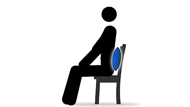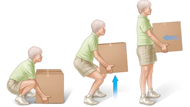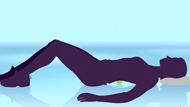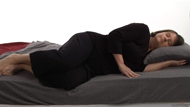Upper and Middle Back Pain
Topic Overview
Is this topic for you?
This topic provides an overview of upper and middle back pain. If you have low back pain or neck pain, see the topic Low Back Pain or Neck Pain.
What is upper and middle back pain?
Upper and middle back pain can occur anywhere from the base of your neck to the bottom of your rib cage.
Your ribs attach to a long, flat bone in the center of the chest called the sternum and attach to and wrap around your back. If a nerve in this area is pinched, irritated, or injured, you may also feel pain in other places where the nerve travels, such as your arms, legs, chest, and belly.
The upper and middle back (called the thoracic spine) has:
- 12 vertebrae. These bones attach to your rib cage. They make up the longest part of your back.
- Discs that separate each vertebra and absorb shock as you move.
- Muscles and ligaments that hold the spine together.
See a picture of the spine.
Upper and middle back pain is not as common as low back pain or neck pain, because the bones in this area of the back don't flex or move as much as the bones in your lower back or neck. Instead, they work with the ribs to keep the back stable and help protect vital organs, such as the heart and lungs.
What causes upper and middle back pain?
Upper and middle back pain may be caused by:
- Overuse, muscle strain, or injury to the muscles, ligaments, and discs that support your spine.
- Poor posture.
- Pressure on the spinal nerves from certain problems, such as a herniated disc.
- A fracture of one of the vertebrae.
- Osteoarthritis caused by the breakdown of cartilage that cushions the small facet joints in the spine.
- Myofascial pain that affects the connective tissue of a muscle or group of muscles.
In rare cases, pain may be caused by other problems, such as gallbladder disease, cancer, or an infection.
What are the symptoms?
Common symptoms of upper and middle back pain are:
- A dull, burning, or sharp pain.
- Muscle tightness or stiffness.
More serious symptoms that need to be treated right away include:
- Weakness in your arms or legs.
- Numbness or tingling in your arms, legs, chest, or belly.
- Loss of bowel or bladder control.
How is upper and middle back pain diagnosed?
Your doctor will first ask you about your past health, your symptoms, and your work and physical activities. Then he or she will do a physical exam. Your doctor may also order an imaging test, such as an X-ray or an MRI, to find out if something such as a broken bone or a herniated disc is causing your pain.
You may need more tests to check for other possible causes for your pain.
How is it treated?
In most cases, people with mild to moderate back pain can manage their symptoms with:
- Over-the-counter pain medicines, such as acetaminophen (for example, Tylenol) and nonsteroidal anti-inflammatory drugs (for example, Advil, Aleve, aspirin, and Motrin).
- Heat or ice.
- Exercise.
- Manual therapy, such as massage, mobilization, or spinal manipulation.
But if your pain gets worse and you're having a hard time doing your daily activities, you may need to take a prescription pain medicine. Surgery is seldom used to treat upper and middle back pain.
How can you care for yourself at home?
There are several things you can do at home to help reduce your pain. For example:
- Rest. If your back hurts a lot, take a break. But try not to let too much time pass before you get moving again. Instead, return to your activities slowly.
- Use over-the-counter pain medicines, such as acetaminophen (for example, Tylenol) and nonsteroidal anti-inflammatory drugs (for example, Advil, Aleve, aspirin, and Motrin). These can reduce pain and swelling. Be safe with medicines. Read and follow all instructions on the label.
- Use a heating pad or ice pack. Heat can reduce pain and stiffness. Ice can help reduce pain and swelling.
- Exercise. Exercises that stretch and strengthen the muscles in your back, shoulders, and stomach can help improve your posture, decrease your chance of injury, and reduce pain.
- Practice good posture. Be sure to stand or sit tall. Don't slump or slouch.
- Learn ways to reduce stress. You might try deep breathing and relaxation exercises or meditation.
Health Tools
Health Tools help you make wise health decisions or take action to improve your health.
Frequently Asked Questions
|
Learning about upper and middle back pain: | |
Being diagnosed: | |
|
Getting treatment: | |
Living with upper and middle back pain: |
Cause
In most cases, upper and middle back pain is caused by:
- Overuse, muscle strain, or injury to the muscles, ligaments, and discs that support your spine.
- Poor posture.
- Myofascial pain that affects the connective tissue of a muscle or group of muscles.
For example, some people hurt their backs when they:
- Slump or slouch when they sit or stand.
- Play sports or do yard work.
- Get jolted in a car accident.
- Get hit hard in the back.
- Lift something too heavy.
Conditions that put pressure on the spinal nerves also can cause pain. These include:
- Osteoarthritis. This occurs when the cartilage that cushions the small facet joints in the spine breaks down. When this happens, the back bones rub together and cause damage and pain. Osteoarthritis is caused by the normal wear and tear of the cartilage as you age.
- A fracture of the vertebrae, which can occur when a lot of force is put on the spine. This force can be from a car or bike accident or a direct blow to the spine. A compression fracture occurs when an injury to the bones in the spine causes them to break and collapse (compress) on each other, such as from a fall. In people who have osteoporosis, which makes the bones brittle and weak, a spinal bone can also break and collapse from only a minor injury or simply moving the wrong way.
- An odd-shaped spine, such as with scoliosis or kyphosis. This can make your back hurt. When you look at a normal spine from the back, it is usually straight. But when a person has scoliosis, the spine curves from side to side, often in an S or C shape. It may also be twisted. When a person has kyphosis, the upper spine is rounded and looks like a hump. In bad cases of scoliosis or kyphosis, a person may have a hard time breathing.
- A herniated disc. This occurs when one of the small, spongy discs that cushion your spine bulges or breaks open and presses on the nerves in the spine. A herniated disc may be caused by normal wear and tear of the disc as you age. Or it may be brought on by activities that you do over and over again that cause a lot of vibration or motion (such as using a jackhammer) or by a sudden heavy strain or increased force to your back. In most cases, a herniated disc occurs in the lower back or neck. It can occur in the upper or middle back, but this is rare. See a picture of a herniated disc.
- Spinal stenosis. The spinal cord runs through an opening in the bones called the spinal canal. Spinal stenosis occurs when that opening narrows. In some cases, bone, ligament, and disc tissue grows into the spinal canal and presses on the nerves that branch out from the spinal cord. The tissue can also squeeze and irritate or injure the spinal cord itself. In most cases, spinal stenosis occurs in the lower back and neck. It can occur in your upper or middle back, but this is rare.
- Degenerative disc disease. This is not really a disease but a term used to describe the normal changes that occur in your spinal discs as you age. Over time, the discs in your spine break down, or degenerate. A loss of fluid in the discs or tiny tears or cracks in the outer layer of the discs can occur over time. The breakdown of the discs can cause back or neck pain, arthritis, spinal stenosis, or a herniated disc. A sudden injury to your back, such as from a fall or a car accident, may also start this process. This problem can occur anywhere on your spine. But in most cases, it occurs in the discs in the lower back and neck.
In rare cases, upper and middle back pain may be caused by other problems, such as gallbladder disease, cancer, or an infection.
Symptoms
In general, symptoms of upper and middle back pain may:
- Feel like a dull, burning, or sharp pain.
- Be felt at a single point or over a broad area.
- Start suddenly or slowly get worse.
- Be constant or come and go.
- Occur with muscle tightness or stiffness.
- Get worse when you do certain activities or move and sit in a certain way.
More serious symptoms that need to be treated right away include:
- Weakness in your arms or legs.
- Numbness or tingling in your arms, legs, chest, or belly.
- Loss of bowel or bladder control.
When to Call a Doctor
In most cases, back pain gets better with home treatment. So unless you have signs of a severe illness, injury, or heart attack, you can give your back pain some time to work itself out before you call your doctor.
Call 911 or other emergency services immediately if:
- Back pain occurs with chest pain or other
symptoms of a heart attack. Symptoms of a heart attack include:
- Chest pain or pressure, or a strange feeling in your chest.
- Sweating.
- Shortness of breath.
- Nausea or vomiting.
- Pain, pressure, or a strange feeling in your back, neck, jaw, upper belly, or one or both shoulders or arms. See a picture of areas where symptoms may be felt.
- Feeling dizzy or lightheaded.
- A fast or uneven heartbeat.
- A person has signs of damage to the
spine after an injury (such as a car accident, fall, or direct blow to the
spine). Signs may include:
- Being unable to move part of the body.
- Severe back or neck pain.
- Weakness, tingling, or numbness in the arms, legs, chest, or belly.
Call your doctor now if:
- You have a new loss of bowel or bladder control.
- You have new numbness in your legs or numbness in your legs that is getting worse.
- You have new weakness in your legs or weakness in your legs that is getting worse. (This could make it hard to stand up.)
- You have new or increased back pain with fever, painful urination, or other signs of a urinary tract infection.
Watchful waiting
Watchful waiting is a wait-and-see approach. If you get better on your own, you won't need treatment. If you get worse, you and your doctor will decide what to do next. If your back pain is mild to moderate, it probably will get better on its own. You can try home treatment to relieve your symptoms. If you don't feel better in 1 to 2 weeks, call your doctor.
Be sure to call your doctor right away if you start to have other symptoms or you have:
- Numbness.
- Weakness.
- Fever.
- Urinary symptoms, such as pain when you urinate.
- Pain that is getting worse.
- Pain that you can't manage at home.
Who to see
Health care professionals who often diagnose the cause of back pain include:
- Primary care providers. This includes:
- Emergency doctors.
If your back pain is severe or long-lasting, health professionals who can treat you include:
You can also get care from:
- Acupuncturists.
- Certified massage therapists.
Exams and Tests
Your doctor will first ask you about your past health, your symptoms, and your work and physical activities. Then he or she will do a physical exam. Your doctor may also order an imaging test to find out if something such as a broken bone or a herniated disc is causing your pain.
The type of imaging test you have depends on what kind of problem your doctor suspects. You may have one or more tests, such as:
- An X-ray to look for injuries or diseases that affect the discs and joints of the spine.
- An MRI to look for injuries and diseases that affect the discs and nerves of the spine, such as a herniated disc, a pinched nerve, or a tumor. It can also show whether any part of the spinal canal has narrowed.
- A CT scan to look for a tumor, a fracture, a herniated disc, narrowing of the spinal canal, or an infection. It can also show whether osteoporosis is the cause of a compression fracture.
- A bone scan to look for damage to the bones, a tumor, or infection, or to find the cause of unexplained back pain.
- An electromyogram and nerve conduction study to check how well the spinal cord, nerve roots, and nerves and muscles that control your arms and legs are working. It can help find out what is causing pain, numbness, or weakness in the arms or legs.
More tests may be done to check for other possible causes for your pain.
Treatment Overview
There are many treatments for upper and middle back pain. What works for someone else may not help you. Work with your doctor to find what is best for you.
Treatment for upper and middle back pain is based on:
- How bad your symptoms are.
- How much your symptoms prevent you from doing your daily tasks.
- How well other treatments have worked.
Treatment for mild to moderate pain
In most cases, people with mild to moderate upper and middle back pain can manage their symptoms with:
- Over-the-counter pain medicines, such as acetaminophen (for example, Tylenol) and nonsteroidal anti-inflammatory drugs (for example, Advil, Aleve, aspirin, and Motrin), to reduce pain. But if these don't get rid of your pain, you may need a prescription pain medicine that is stronger.
- Heat or ice to reduce pain and stiffness.
- Exercise to stretch and strengthen the muscles of your back, shoulders, and stomach.
- Physical therapy to help increase your flexibility, strength, and balance. Your physical therapist may teach you an exercise program so you can do it at home.
- Massage to help reduce muscle tension and pain for a short time and to improve blood flow.
- Spinal manipulation to help relieve pain and improve function. It can range from massage and slow pressing to a quick thrust.
- Acupuncture. It involves putting tiny needles into your skin at certain points on the body to promote healing and pain relief.
- Capsaicin cream may help relieve pain.footnote 1 Capsaicin is a substance contained in cayenne peppers. Capsaicin cream is applied directly to the skin over the painful area.
Treatment if back pain gets worse
If your back pain doesn't get better or it gets worse, your doctor may recommend:
- Prescription medicines, such as opioids, to help reduce pain.
- Muscle relaxants to help reduce pain and muscle tension and improve mobility. These can help with severe muscle spasms that happen when the back pain starts (acute phase).
- Antidepressants, such duloxetine, to help treat long-lasting (chronic) back pain.
- Steroid shots to help reduce swelling and relieve pressure on nerves and nerve roots. But there is little evidence showing that these shots can help control back pain.
In some cases, a back brace may be used to support the bones in the spine after a fracture.
Surgery is seldom used to treat upper and middle back pain. If your doctor recommends surgery, the type will depend on the problem you have. Before you decide to have surgery, it's a good idea to get a second opinion from a different doctor. Surgery choices may include:
- Kyphoplasty or vertebroplasty. Bone cement is injected through a needle into the broken vertebrae to try to stabilize the bone. These surgeries are not done very often, because most fractures heal on their own. And there is no evidence that kyphoplasty or vertebroplasty are better than nonsurgical treatment.footnote 2
- Herniated disc removal. It removes the portion of the disc that is herniated and pushing into the spinal canal. In most cases, herniated discs that occur in the upper and middle back are small and don't need surgery. But you may need surgery for a large herniated disc that presses on the spinal cord.
- Spinal decompression for stenosis. It widens the spinal canal that has narrowed, and it relieves pressure on the spinal cord or nerves. This procedure is not done very often, because spinal stenosis in the upper and middle back is rare.
Home Treatment
There are several things you can do at home to help reduce your pain. For example:
- Rest. If your back hurts a lot, take a break. But try not to let too much time pass before you get moving again. Instead, return to your activities slowly, and avoid things that make your pain worse. Studies show that bed rest doesn't relieve back pain better than staying active. And bed rest of more than a couple of days can make your back pain worse and lead to other problems, such as stiff joints and muscle weakness.
- Use over-the-counter pain medicines, such as acetaminophen (for example, Tylenol) and nonsteroidal anti-inflammatory drugs (for example, Advil, Aleve, aspirin, and Motrin). These can reduce pain and swelling. Be safe with medicines. Read and follow all instructions on the label.
- Use a heating pad or ice pack. Heat can reduce pain and stiffness. Ice can help reduce pain and swelling. You might want to switch back and forth between heat and cold until you find what helps you the most.
- Exercise. Ask your doctor or a physical therapist about what kinds of exercises you can do to stretch and strengthen the muscles in your back, shoulders, and stomach. These muscles help support your spine. Strong muscles can help improve your posture, keep your body in better balance, decrease your chance of injury, and reduce pain.
- Practice good posture. Poor posture puts stress on your back. Be sure to stand or sit tall, with your shoulders and your stomach pulled in to support your back. Don't slump or slouch.
Here are some other things you can do to feel better:
- See a counselor. Cognitive-behavioral therapy can show you how to change certain thoughts and behaviors to control your pain. For more information, see the topic Stop Negative Thoughts: Choosing a Healthier Way of Thinking.
- Learn ways to reduce stress. Stress can make your pain feel worse. You might try deep breathing and relaxation exercises or meditation.
- Eat nutritious foods. Getting plenty of calcium and vitamin D may help prevent osteoporosis, which can lead to compression fractures and back pain. For more information, see the topic Healthy Eating.
- Don't smoke. Smoking decreases blood flow and slows healing. If you need help quitting, see the topic Quitting Smoking.
- Take extra care when you lift. When you must lift, bend your knees and keep your back straight. Avoid twisting. Keep the load close to your body.
- Use a pain diary (What is a PDF document?). Write down how your moods, thoughts, sleep patterns, activities, and medicines affect your pain. Having a record of your pain can help you and your doctor find the best ways to treat your pain.
Other Places To Get Help
Organizations
Related Information
References
Citations
- Gagnier JJ, et al. (2016). Herbal medicine for low back pain: A Cochrane review. Spine, 41(2): 116-133. DOI: 10.1097/BRS.0000000000001310. Accessed June 17, 2016.
- Esses SI, et al. (2011). The treatment of symptomatic osteoporotic spinal compression fractures. Journal of the American Academy of Orthopaedic Surgeons, 19(3): 176-182. Also available online: http://www.aaos.org/research/guidelines/guide.asp.
Other Works Consulted
- Hansen TJ (2015). Thoracic compression fracture. In WR Frontera et al., eds., Essentials of Physical Medicine and Rehabilitation, 3rd ed., pp. 211-216. Philadelphia: Saunders.
- Mercier LR (2008). The back. In Practical Orthopedics, 6th ed., pp. 143-184. Philadelphia: Mosby Elsevier.
Credits
ByHealthwise Staff
Primary Medical Reviewer William H. Blahd, Jr., MD, FACEP - Emergency Medicine
E. Gregory Thompson, MD - Internal Medicine
Adam Husney, MD - Family Medicine
Specialist Medical Reviewer Kathleen Romito, MD - Family Medicine
Current as ofFebruary 23, 2018
- Top of Page
Next Section:
Health Tools
Previous Section:
Topic Overview- Top of Page
Next Section:
Frequently Asked Questions
Previous Section:
Health Tools- Top of Page
Next Section:
Cause
Previous Section:
Frequently Asked Questions- Top of Page
Next Section:
Symptoms
Previous Section:
Cause- Top of Page
Next Section:
When to Call a Doctor
Previous Section:
Symptoms- Top of Page
Next Section:
Exams and Tests
Previous Section:
When to Call a Doctor- Top of Page
Next Section:
Treatment Overview
Previous Section:
Exams and Tests- Top of Page
Next Section:
Home Treatment
Previous Section:
Treatment Overview- Top of Page
Next Section:
Other Places To Get Help
Previous Section:
Home Treatment- Top of Page
Next Section:
Related Information
Previous Section:
Other Places To Get Help- Top of Page
Next Section:
References
Previous Section:
Related Information- Top of Page
Next Section:
Credits
Previous Section:
References- Top of Page
Current as of: February 23, 2018










